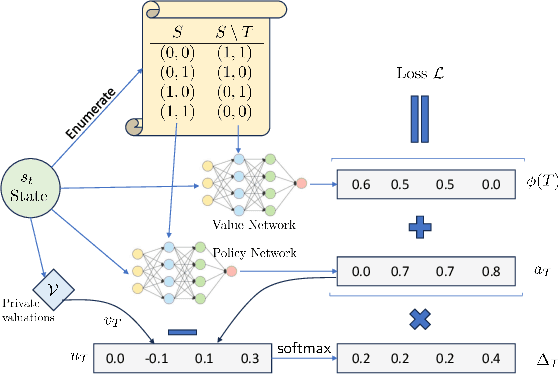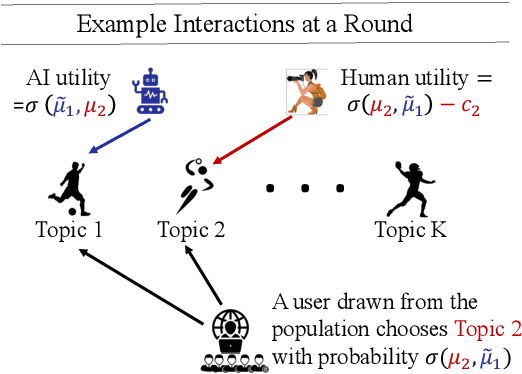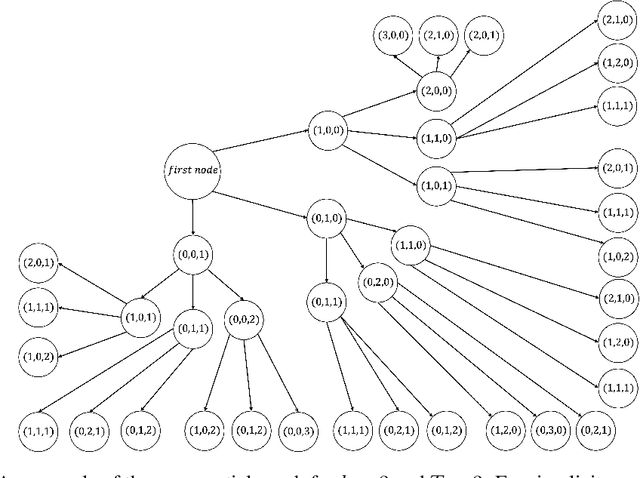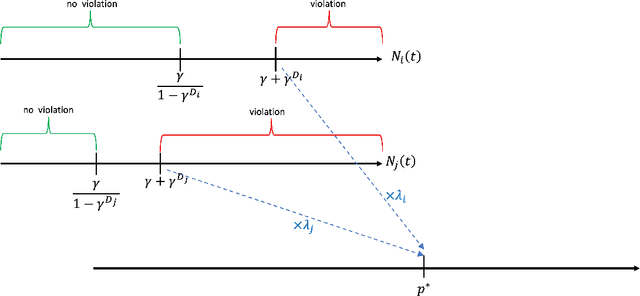Zhe Feng
Unisoma: A Unified Transformer-based Solver for Multi-Solid Systems
Jun 06, 2025Abstract:Multi-solid systems are foundational to a wide range of real-world applications, yet modeling their complex interactions remains challenging. Existing deep learning methods predominantly rely on implicit modeling, where the factors influencing solid deformation are not explicitly represented but are instead indirectly learned. However, as the number of solids increases, these methods struggle to accurately capture intricate physical interactions. In this paper, we introduce a novel explicit modeling paradigm that incorporates factors influencing solid deformation through structured modules. Specifically, we present Unisoma, a unified and flexible Transformer-based model capable of handling variable numbers of solids. Unisoma directly captures physical interactions using contact modules and adaptive interaction allocation mechanism, and learns the deformation through a triplet relationship. Compared to implicit modeling techniques, explicit modeling is more well-suited for multi-solid systems with diverse coupling patterns, as it enables detailed treatment of each solid while preventing information blending and confusion. Experimentally, Unisoma achieves consistent state-of-the-art performance across seven well-established datasets and two complex multi-solid tasks. Code is avaiable at \href{this link}{https://github.com/therontau0054/Unisoma}.
LaDEEP: A Deep Learning-based Surrogate Model for Large Deformation of Elastic-Plastic Solids
Jun 06, 2025Abstract:Scientific computing for large deformation of elastic-plastic solids is critical for numerous real-world applications. Classical numerical solvers rely primarily on local discrete linear approximation and are constrained by an inherent trade-off between accuracy and efficiency. Recently, deep learning models have achieved impressive progress in solving the continuum mechanism. While previous models have explored various architectures and constructed coefficient-solution mappings, they are designed for general instances without considering specific problem properties and hard to accurately handle with complex elastic-plastic solids involving contact, loading and unloading. In this work, we take stretch bending, a popular metal fabrication technique, as our case study and introduce LaDEEP, a deep learning-based surrogate model for \textbf{La}rge \textbf{De}formation of \textbf{E}lastic-\textbf{P}lastic Solids. We encode the partitioned regions of the involved slender solids into a token sequence to maintain their essential order property. To characterize the physical process of the solid deformation, a two-stage Transformer-based module is designed to predict the deformation with the sequence of tokens as input. Empirically, LaDEEP achieves five magnitudes faster speed than finite element methods with a comparable accuracy, and gains 20.47\% relative improvement on average compared to other deep learning baselines. We have also deployed our model into a real-world industrial production system, and it has shown remarkable performance in both accuracy and efficiency.
Multimodal Fusion and Vision-Language Models: A Survey for Robot Vision
Apr 03, 2025Abstract:Robot vision has greatly benefited from advancements in multimodal fusion techniques and vision-language models (VLMs). We systematically review the applications of multimodal fusion in key robotic vision tasks, including semantic scene understanding, simultaneous localization and mapping (SLAM), 3D object detection, navigation and localization, and robot manipulation. We compare VLMs based on large language models (LLMs) with traditional multimodal fusion methods, analyzing their advantages, limitations, and synergies. Additionally, we conduct an in-depth analysis of commonly used datasets, evaluating their applicability and challenges in real-world robotic scenarios. Furthermore, we identify critical research challenges such as cross-modal alignment, efficient fusion strategies, real-time deployment, and domain adaptation, and propose future research directions, including self-supervised learning for robust multimodal representations, transformer-based fusion architectures, and scalable multimodal frameworks. Through a comprehensive review, comparative analysis, and forward-looking discussion, we provide a valuable reference for advancing multimodal perception and interaction in robotic vision. A comprehensive list of studies in this survey is available at https://github.com/Xiaofeng-Han-Res/MF-RV.
Online Bidding under RoS Constraints without Knowing the Value
Mar 05, 2025Abstract:We consider the problem of bidding in online advertising, where an advertiser aims to maximize value while adhering to budget and Return-on-Spend (RoS) constraints. Unlike prior work that assumes knowledge of the value generated by winning each impression ({e.g.,} conversions), we address the more realistic setting where the advertiser must simultaneously learn the optimal bidding strategy and the value of each impression opportunity. This introduces a challenging exploration-exploitation dilemma: the advertiser must balance exploring different bids to estimate impression values with exploiting current knowledge to bid effectively. To address this, we propose a novel Upper Confidence Bound (UCB)-style algorithm that carefully manages this trade-off. Via a rigorous theoretical analysis, we prove that our algorithm achieves $\widetilde{O}(\sqrt{T\log(|\mathcal{B}|T)})$ regret and constraint violation, where $T$ is the number of bidding rounds and $\mathcal{B}$ is the domain of possible bids. This establishes the first optimal regret and constraint violation bounds for bidding in the online setting with unknown impression values. Moreover, our algorithm is computationally efficient and simple to implement. We validate our theoretical findings through experiments on synthetic data, demonstrating that our algorithm exhibits strong empirical performance compared to existing approaches.
Deep Reinforcement Learning for Sequential Combinatorial Auctions
Jul 10, 2024



Abstract:Revenue-optimal auction design is a challenging problem with significant theoretical and practical implications. Sequential auction mechanisms, known for their simplicity and strong strategyproofness guarantees, are often limited by theoretical results that are largely existential, except for certain restrictive settings. Although traditional reinforcement learning methods such as Proximal Policy Optimization (PPO) and Soft Actor-Critic (SAC) are applicable in this domain, they struggle with computational demands and convergence issues when dealing with large and continuous action spaces. In light of this and recognizing that we can model transitions differentiable for our settings, we propose using a new reinforcement learning framework tailored for sequential combinatorial auctions that leverages first-order gradients. Our extensive evaluations show that our approach achieves significant improvement in revenue over both analytical baselines and standard reinforcement learning algorithms. Furthermore, we scale our approach to scenarios involving up to 50 agents and 50 items, demonstrating its applicability in complex, real-world auction settings. As such, this work advances the computational tools available for auction design and contributes to bridging the gap between theoretical results and practical implementations in sequential auction design.
How to Strategize Human Content Creation in the Era of GenAI?
Jun 07, 2024



Abstract:Generative AI (GenAI) will have significant impact on content creation platforms. In this paper, we study the dynamic competition between a GenAI and a human contributor. Unlike the human, the GenAI's content only improves when more contents are created by human over the time; however, GenAI has the advantage of generating content at a lower cost. We study the algorithmic problem in this dynamic competition model about how the human contributor can maximize her utility when competing against the GenAI for content generation over a set of topics. In time-sensitive content domains (e.g., news or pop music creation) where contents' value diminishes over time, we show that there is no polynomial time algorithm for finding the human's optimal (dynamic) strategy, unless the randomized exponential time hypothesis is false. Fortunately, we are able to design a polynomial time algorithm that naturally cycles between myopically optimizing over a short time window and pausing and provably guarantees an approximation ratio of $\frac{1}{2}$. We then turn to time-insensitive content domains where contents do not lose their value (e.g., contents on history facts). Interestingly, we show that this setting permits a polynomial time algorithm that maximizes the human's utility in the long run.
Auctions with LLM Summaries
Apr 11, 2024Abstract:We study an auction setting in which bidders bid for placement of their content within a summary generated by a large language model (LLM), e.g., an ad auction in which the display is a summary paragraph of multiple ads. This generalizes the classic ad settings such as position auctions to an LLM generated setting, which allows us to handle general display formats. We propose a novel factorized framework in which an auction module and an LLM module work together via a prediction model to provide welfare maximizing summary outputs in an incentive compatible manner. We provide a theoretical analysis of this framework and synthetic experiments to demonstrate the feasibility and validity of the system together with welfare comparisons.
Improved Online Learning Algorithms for CTR Prediction in Ad Auctions
Feb 29, 2024Abstract:In this work, we investigate the online learning problem of revenue maximization in ad auctions, where the seller needs to learn the click-through rates (CTRs) of each ad candidate and charge the price of the winner through a pay-per-click manner. We focus on two models of the advertisers' strategic behaviors. First, we assume that the advertiser is completely myopic; i.e.~in each round, they aim to maximize their utility only for the current round. In this setting, we develop an online mechanism based on upper-confidence bounds that achieves a tight $O(\sqrt{T})$ regret in the worst-case and negative regret when the values are static across all the auctions and there is a gap between the highest expected value (i.e.~value multiplied by their CTR) and second highest expected value ad. Next, we assume that the advertiser is non-myopic and cares about their long term utility. This setting is much more complex since an advertiser is incentivized to influence the mechanism by bidding strategically in earlier rounds. In this setting, we provide an algorithm to achieve negative regret for the static valuation setting (with a positive gap), which is in sharp contrast with the prior work that shows $O(T^{2/3})$ regret when the valuation is generated by adversary.
DelucionQA: Detecting Hallucinations in Domain-specific Question Answering
Dec 08, 2023



Abstract:Hallucination is a well-known phenomenon in text generated by large language models (LLMs). The existence of hallucinatory responses is found in almost all application scenarios e.g., summarization, question-answering (QA) etc. For applications requiring high reliability (e.g., customer-facing assistants), the potential existence of hallucination in LLM-generated text is a critical problem. The amount of hallucination can be reduced by leveraging information retrieval to provide relevant background information to the LLM. However, LLMs can still generate hallucinatory content for various reasons (e.g., prioritizing its parametric knowledge over the context, failure to capture the relevant information from the context, etc.). Detecting hallucinations through automated methods is thus paramount. To facilitate research in this direction, we introduce a sophisticated dataset, DelucionQA, that captures hallucinations made by retrieval-augmented LLMs for a domain-specific QA task. Furthermore, we propose a set of hallucination detection methods to serve as baselines for future works from the research community. Analysis and case study are also provided to share valuable insights on hallucination phenomena in the target scenario.
Learning Thresholds with Latent Values and Censored Feedback
Dec 07, 2023Abstract:In this paper, we investigate a problem of actively learning threshold in latent space, where the unknown reward $g(\gamma, v)$ depends on the proposed threshold $\gamma$ and latent value $v$ and it can be $only$ achieved if the threshold is lower than or equal to the unknown latent value. This problem has broad applications in practical scenarios, e.g., reserve price optimization in online auctions, online task assignments in crowdsourcing, setting recruiting bars in hiring, etc. We first characterize the query complexity of learning a threshold with the expected reward at most $\epsilon$ smaller than the optimum and prove that the number of queries needed can be infinitely large even when $g(\gamma, v)$ is monotone with respect to both $\gamma$ and $v$. On the positive side, we provide a tight query complexity $\tilde{\Theta}(1/\epsilon^3)$ when $g$ is monotone and the CDF of value distribution is Lipschitz. Moreover, we show a tight $\tilde{\Theta}(1/\epsilon^3)$ query complexity can be achieved as long as $g$ satisfies one-sided Lipschitzness, which provides a complete characterization for this problem. Finally, we extend this model to an online learning setting and demonstrate a tight $\Theta(T^{2/3})$ regret bound using continuous-arm bandit techniques and the aforementioned query complexity results.
 Add to Chrome
Add to Chrome Add to Firefox
Add to Firefox Add to Edge
Add to Edge